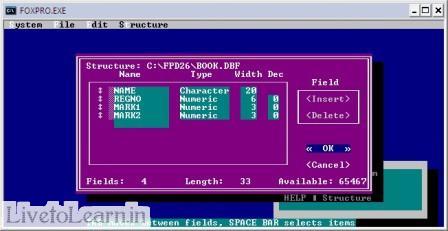Run your DOS FoxPro applications on Windows Vista and above 64 bit operating systems

A FoxPro 2.6 for DOS/Windows compiled FXP or APP file will work just fine in FoxPro 2.6 for DOS, FoxPro 2.6 for Windows, FoxPro 2.6 for Macintosh, or FoxPro 2.6 for Unix. All you need is a runtime. An example of a runtime can be found in the freeware section of this web site. Foxpro for MS-DOS - Basic FoxPro 2.6 Commands FoxPro is SEMI-RDBMS Unlike other RDBMS systems, in FoxPro each database can contain only one table. Hence, the single table is called as database in this tutorial In FoxPro, first four characters of any command is enough to execute For e.g.:- crea create 1. TO OPEN A DATABASE: Syn: use. FoxPro was a text-based procedurally oriented programming language and database management system (DBMS), and it was also an object-oriented programming language, originally published by Fox Software and later by Microsoft, for MS-DOS, Windows, Macintosh, and UNIX.The final published release of FoxPro was 2.6. Development continued under the Visual FoxPro label, which in turn was.
Simply the fastest way to run FoxPro for DOS on a Windows 64-bit operating system.
Live file system
The underlying file system used by the dbDOS™ VM is brand new and adds significant functionality and increases the speed of the VM by as much as 38% over the prior engines.
Print on Modern hardware
dbDOS PRO 6 comes with multiple ways of printing. In addition to printing on modern hardware, we have also included a set of retro printer drivers.
Print to PDF
dbDOS™ PRO 6 is unique from any other DOS based emulation. The underlying engine is both a Virtual Machine (VM) and an emulator to give the best of both worlds and a great out-of-the-box experience.
Copy from Windows to dbDOS™
You can copy text from a Windows application using the CTRL-C and paste that text into the dbDOS™ system by pressing Ctrl-F9 or clicking the dbDOS™ PRO 6 VM System menu as shown above and selecting the paste option from the menu.
Copy from dbDOS™ to Windows
Proprietary DOS Emulation Virtual Machine Hybrid
dbDOS™ PRO 6 is unique from any other DOS based emulation. The underlying engine is both a Virtual Machine (VM) and an emulator to give the best of both worlds and a great out-of-the-box experience.
Hotkey screen print
In the old DOS based programs, there was the ability to print the screen contents to a printer. Pressing the Ctrl-PrnScr button or clicking the dbDOS™ PRO 6’s System menu option that will take a screen shot of the current screen and send it to a printer or clipboard for further processing.
User adjustable screen resolution
dbDOS™ PRO 6 allows for setting the screen size to best fit your existing monitors and display cards. dbDOS™ can also support full-screen mode, however the product gives you the flexibility to work at your desired resolution.
Easy to use Configuration Manager
Run almost any DOS based product
Run almost any DOS based product
dbDOS™ PRO 6 can run practically any DOS based program. This includes your favorite games, databases (Paradox, dBASE, FoxPro, etc), and office software (Lotus 123, Word Perfect, WordStar, etc).

No additional software needed
dbDOS™ PRO 6 comes with everything you need; the ability to change screen resolutions, printers, and different formats all at one low price. No need for any other software, just dbDOS™ PRO 6 and the DOS based software you want to run and use.
1000s of users from around the world!
Users from around the world already use dbDOS™ for their DOS based dBASE programs, applications, and data… it works the same for Paradox!
All you need is dbDOS™ PRO 6 and a copy of FoxPro for DOS and you are ready to go!
Not ready to buy yet, then learn more about dbDOS™
Microsoft Foxpro 6
FoxPro was a text-basedprocedurally orientedprogramming language and database management system (DBMS), and it was also an object-oriented programming language, originally published by Fox Software and later by Microsoft, for MS-DOS, Windows, Macintosh, and UNIX. The final published release of FoxPro was 2.6. Development continued under the Visual FoxPro label, which in turn was discontinued in 2007.

Microsoft Visual Foxpro 6.0 Download
FoxPro was derived from FoxBase (Fox Software, Perrysburg, Ohio), which was in turn derived from dBase III (Ashton-Tate) and dBase II. dBase II was the first commercial version of a database program written by Wayne Ratliff, called Vulcan, running on CP/M, as does dBase II.[1]
FoxPro was both a DBMS and a relational database management system (RDBMS), since it extensively supported multiple relationships between multiple DBF files (tables). However, it lacked transactional processing.
FoxPro was sold and supported by Microsoft after they acquired Fox Software in its entirety in 1992. At that time there was an active worldwide community of FoxPro users and programmers. FoxPro 2.6 for UNIX (FPU26) has even been successfully installed on Linux and FreeBSD using the Intel Binary Compatibility Standard (ibcs2) support library.
Version information[edit]
Operating system compatibility[edit]
| Version | FP 2.0 | FP 2.5 | FP 2.6 |
|---|---|---|---|
| MS-DOS | Yes | Yes | Yes |
| Windows 3.1 to 7 Ultimate sp1 | Yes | Yes | Yes |
| Macintosh | Yes | Yes | Yes |
| SCO UNIX | Yes | Yes | Yes |
| Linux & FreeBSD | Yes | Yes | Yes[2] |
| Windows 2000 | No | No | Yes |

Foxpro 2.6 For Dos
Technical aspects[edit]
Foxpro Microsoft
FoxPro 2 included the 'Rushmore' optimizing engine, which used indices to accelerate data retrieval and updating. Rushmore technology examined every